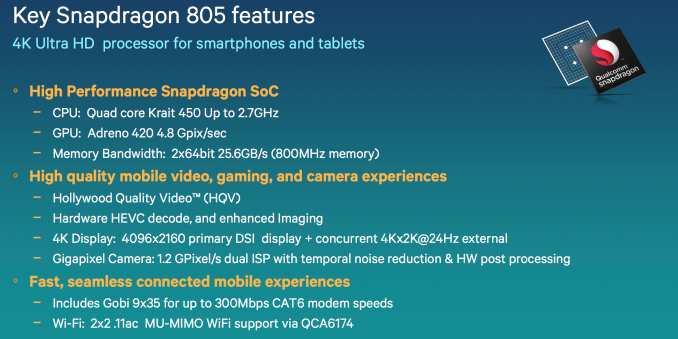Qualcomm Snapdragon 805 Performance Preview
by Anand Lal Shimpi on May 21, 2014 8:00 PM EST- Posted in
- Tablets
- Snapdragon
- Qualcomm
- Mobile
- SoCs
- Snapdragon 805
Final Words
Qualcomm tends to stagger the introduction of new CPU and GPU IP. Snapdragon 805 ultimately serves as Qualcomm's introduction vehicle for its Adreno 420 GPU. The performance gains there over Adreno 330/Snapdragon 801 can be substantial, particularly at high resolutions and/or higher quality settings. Excluding 3DMark, we saw a 20 - 50% increase in GPU performance compared to Snapdragon 801. Adreno 420 is a must have if you want to drive a higher resolution display at the same performance as an Adreno 330/1080p display combination. With OEMs contemplating moving to higher-than-1080p resolution screens in the near term, leveraging Snapdragon 805 may make sense there.
The gains on the CPU side are far more subtle. At best we noted a 6% increase in performance compared to a 2.5GHz Snapdragon 801, but depending on thermal/chassis limitations of shipping devices you may see even less of a difference.
Qualcomm tells us that some of its customers will choose to stay on Snapdragon 801 until the 810 arrives next year, while some will choose to release products based on 805 in the interim. Based on our results here, if an OEM is looking to specifically target the gaming market I can see Snapdragon 805 making a lot of sense. For most of those OEMs that just launched Snapdragon 801 based designs however, I don't know that there's a huge reason to release a refresh in the interim.
I am curious to evaluate the impact of ISP changes as well as dive deeper into 4K capture and H.265 decode, but that will have to wait until we see shipping designs. The other big question is just how power efficient Adreno 420 is compared to Adreno 330. Qualcomm's internal numbers are promising, citing a 20% reduction in power consumption at effectively the same performance in GFXBench's T-Rex HD onscreen test.












149 Comments
View All Comments
B.Jay - Wednesday, May 21, 2014 - link
Too bad it seems like the LG G3 might not have this beast... So close LG, so close!erikiksaz - Wednesday, May 21, 2014 - link
I wonder what the scrolling performance will be like on the G3 given its resolution and "just" having an 801 chip. I feel like scrolling performance is finally good with the 1080p and the latest generation of processors, but are we going backwards in performance with the leap to 4k?Impulses - Thursday, May 22, 2014 - link
Still dunno why they're pushing for even higher DPI on phones, seems almost absurd at this point.piroroadkill - Thursday, May 22, 2014 - link
Because people are very, very simple in the head and think bigger numbers are better.Frenetic Pony - Thursday, May 22, 2014 - link
"Now assembled by 100% more unpaid Chinese interns!"Vayra - Monday, June 2, 2014 - link
High DPI phones will hopefully die a silent and quick death. Even 1080p is overkill for me on any screen smaller than 5 inch, and staying at 720p at that size is great for battery life...Teo222 - Thursday, June 5, 2014 - link
I don't know man. The difference in pushing and power consumption and price between 720p and 1080p is not that much to deter from the noticeably better quality.Say what you will but I (with my less than perfect vision) can still see pixelation at battery indicators or other small elements. Not to mention native full HD content should you wish it. and obviously SOCs today able to cope with 1080p.
Sabresiberian - Thursday, May 22, 2014 - link
I'm not sure why some people spend as much effort deriding the push for higher pixel densities as they do. Most of it sounds more like sneering for the sake of sneering than having an actual point to make, to me (I'm not saying I know that to be the case here). One should at least make the effort to differentiate himself from the person telling us we should not try to improve the quality of what we see by reaching for more than 60 DPI not all that long ago, because that was "good enough".Human vision isn't the simple mechanism some people think it is. Research has shown a density of over 600 DPI can be useful. I tend to agree that there are other ways to make smart phones better at this point, and it's hard for me to imagine that I would be able to see any benefit beyond 300 DPI personally, but I'm not against increasing the ability of our technology to do more than we can use. Perhaps the technology will lead to improvements in other areas, like responsiveness, or fluidity. Seems to me that giving designing engineers all the power they could possibly use can't be a bad thing. :)
Egg - Friday, May 23, 2014 - link
Increased power draw, cost, performance issues.Frenetic Pony - Saturday, May 24, 2014 - link
Hey looks reasons!